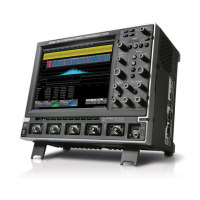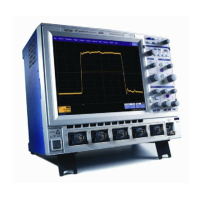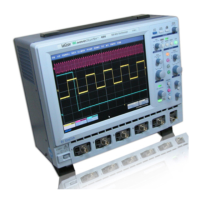218 WM-OM-E Rev I
To Set Up Continuous Averaging
1. In the menu bar, touch Math, then Math Setup... in the drop-down menu.
2. Select a function tab from F1 through Fx [The number of math traces available depends on
the software options loaded on your scope. See Specifications.].
3. Touch inside the Source1 field and select a source waveform from the pop-up menu.
4. Touch inside the Operator1 field and select Average from the Select Math Operator
menu.
5. Touch the Average tab in the dialog to the right of the "Fx" dialog, touch the Continuous
button.
6. Touch inside the Sweeps data entry field and enter a value using the pop-up keypad. The
valid range is 1 to 1,000,000 sweeps.
To Set Up Summed Averaging
1. In the menu bar, touch Math, then Math Setup... in the drop-down menu.
2. Select a function tab from F1 through Fx [The number of math traces available depends on
the software options loaded on your scope. See Specifications.].
3. Touch inside the Source1 field and select a source waveform from the pop-up menu.
4. Touch inside the Operator1 field and select Average from the Select Math Operator
menu.
5. Touch the Average tab in the dialog to the right of the "Fx" dialog, then touch the Summed
button.
6. Touch inside the Sweeps data entry field and type in a value using the pop-up keypad. The
valid range is 1 to 1,000,000 sweeps.
Enhanced Resolution
ERES (Enhanced Resolution) filtering increases vertical resolution, allowing you to distinguish
closely spaced voltage levels. The functioning of the instrument's ERES is similar to smoothing the
signal with a simple, moving-average filter. However, it is more efficient concerning bandwidth and
pass-band filtering. Use ERES on single-shot waveforms, or where the data record is slowly
repetitive (when you cannot use averaging). Use it to reduce noise when your signal is noticeably
noisy, but you do not need to perform noise measurements. Also use it when you perform
high-precision voltage measurements: zooming with high vertical gain, for example.
How the Instrument Enhances Resolution
The instrument's enhanced resolution feature improves vertical resolution by a fixed amount for
each filter. This real increase in resolution occurs whether or not the signal is noisy, or your signal is
single-shot or repetitive. The signal-to-noise ratio (SNR) improvement you gain is dependent on the
form of the noise in the original signal. The enhanced resolution filtering decreases the bandwidth
of the signal, filtering out some of the noise.
The instrument's constant phase FIR (Finite Impulse Response) filters provide fast computation,
